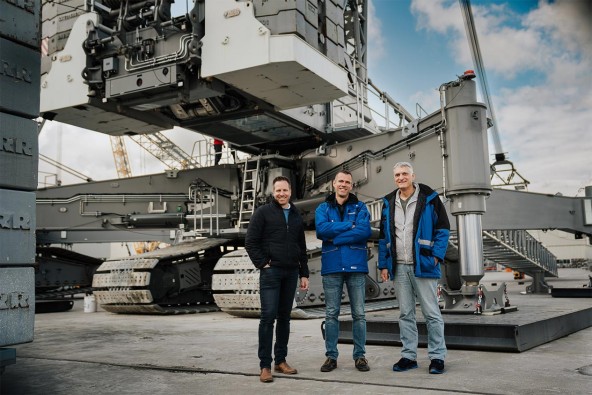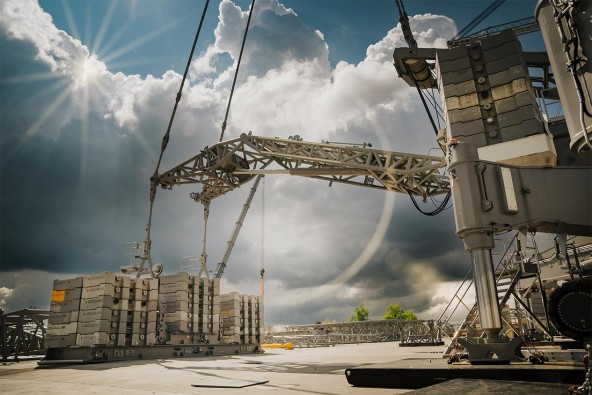
8 minutes - magazine 02 | 2023
Big impact on narrow track
Improved for use in wind farms, narrow track crawler cranes travel from one turbine to the next and are quickly ready to work.
Hitting the heights on a narrow track
As early as 20 years ago, we developed the first crane of its kind, the LR 1400/2-W. This made us the inventors of the narrow track lattice boom crawler crane. And because these cranes are specially designed for wind farms, we even added a “W” – for wind – to their name.
We successfully sold and built our narrow track 400 tonne crane for many years... until it became too small. Wind turbine towers were getting taller and their components heavier. In response, we launched the significantly more powerful LR 1600/2-W back in 2010, of which around 50 are still in action around the world. But history repeats itself! “Assembly of the latest generation of wind turbines now requires cranes with an even greater lifting capacity. Which is why weʼve now developed a narrow track version of our LR 1700-1.0,” explains Martin Frankenhauser. As a product and market specialist in our technical sales department for crawler cranes, he looks after the new crane, whose name also ends with a “W” – the LR 1700-1.0W.

Crawler crane experts in front of the new LR 1700-1.0W: (from left to right) Martin Frankenhauser, Steffen Schwertle, Markus Zeiler.
The most powerful and highest on the market
Just as the LR 1700-1.0 replaced the LR 1600/2 in our line-up almost two years ago, the narrow track version of the 600 tonne crane is now also being replaced by the new 700 tonne LR 1700-1.0W. “The biggest differences compared to the predecessor model, the LR 1600/2-W, are the new craneʼs significantly higher lifting capacities and hoisting heights. This is mainly due to the significantly more powerful basic machine as well as the 3.5 metre wide H-lattice sections at the lower end of the main boom, which increase the lateral stability of the entire system,” explains Frankenhauser. “The increase in performance is enormous. For example, if we compare the longest wind turbine boom with the derrick system on the previous model (156 metre main boom plus twelve metre lattice type fixed jib) with the new one, which has the same boom length, the latest model delivers a 64 per cent increase in lifting capacity. Thatʼs an increase from 73 to over 120 tonnes! In addition, the new LR 1700-1.0W can be set up with longer boom systems, gaining 15 metres with a derrick system and six metres without one. Our 700 tonne crane is the most powerful and highest narrow track crane on the market.”
Technical data
- Max. capacity: 700 t
- Max. load moment: 9,650
- Max. boom system length: 102 + 96 m
- Max. boom length: 165 m
- Output: 400 kW
- Width crawler chasis: 5.9 m
Our new crane thus meets the more challenging requirements of working on modern wind turbines with hub heights of up to 170 metres. The highest demand for the new narrow track 700 tonne cranes comes from the Iberian Peninsula and Latin America, where the previous crane was particularly popular. “There are large wind farms where our customers want to move the cranes, whilst they are at least partially assembled, on roads that are about six metres wide, to avoid heavy transports of crane components wherever possible,” explains Martin Frankenhauser.

The chassis of the LR 1700-1.0W is just 5.9 metres wide.
Heavy-duty travel gear
Since crawler cranes, and particularly narrow track models, must be able to cope with long distances and inclines at wind farms, our designers placed a special focus on maximising the performance of the new LR 1700-1.0Wʼs drivetrain. Markus Zeiler is Head of Crawler Undercarriage Design at Liebherr in Ehingen: “Our customers want to travel even longer distances with maximum equipment. So wear and tear is a major issue.”
For this reason, weʼve given the LR 1700 narrow track crawler carrier some proven components from our next larger crane class. We use these as a modular system on all our larger vehicles from the LR 1800-1.0 to the LR 11350. “This means that the larger components are less heavily loaded and, in addition, we can distribute the crane weight over more track rollers – all of which helps to reduce wear. A lot of power is needed to steer the crawler chassis, which is only 5.9 metres wide, because the lever ratios are much less favourable than with the wide crawler travel gear. Here, too, the stronger “heavyduty travel gear” helps. It provides about 40 per cent more drive power than the standard variant. As a result, the new narrow 700 tonne crane runs almost at idle speed when driving straight ahead.”

The narrow track version also uses the hydraulically adjustable V-Frame® ballast guide.
Extensive static calculations
It is in the nature of things that the overall centre of gravity of crawler cranes with long lattice booms is several metres above the ground. When moving these giants, especially with narrow travel gear, safety is the top priority. “We have worked out travel tables for each of the LR 1700-1.0Wʼs operating modes. There are a lot of variables: with or without a derrick, different boom systems and lengths and a wide variety of ballast variants. But this is the only way to ensure safe procedures. Our customers need to know which gradients are possible with which equipment,” explains Steffen Schwertle, who is responsible for narrow track cranes in our structural engineering department and was tasked with calculating the limits for the new crane.
On the narrow track crane, the lateral inclination is limited to two degrees, while the longitudinal inclination can be up to ten degrees, depending on the configuration. “That corresponds to gradients up to about 18 per cent, a massive value! With these big gradients, of course, you can no longer drive with very long systems. Our customers can conveniently view the required retrofit variant in the work planner and configure it directly in the LICCON control system. The corresponding ground pressures are also displayed there,” says Schwertle.

The heavy-duty travel gear on the new narrow track crane is intensively tested on gradients of up to 18 per cent.
The work planner shows the required jib angle to adjust the overall centre of gravity of the crane to the slope of the ground. “To keep the centre of gravity as low as possible when driving the new narrow track crane, part of the slewing platform ballast is placed on a turntable extension and we work with central ballast on the side of the undercarriage. For this ballast variant, which is optimised for the craneʼs centre of gravity, we have also calculated load charts for the craneʼs operation,” explains Steffen Schwertle.
“By the way, the narrow track crane has the advantage that the ground in the crane set-up area doesnʼt need to be levelled as carefully, because it works on supports and can thus optimally level itself,” says Martin Frankenhauser. “And it even offers greater load-bearing capacity than the wide crawler crane, since any lateral inclinations donʼt need to be taken into account statically,” adds Steffen Schwertle.
Maximum flexibility
We now also offer the heavy-duty travel gear for the wide chassis of the LR 1700-1.0. Markus Zeiler explains why: “If a customer drives a lot, the reinforced undercarriage reduces wear and the crane can even be equipped with 2.4 metre base plates on the wide version, 40 centimentres more than on both the standard version and the narrow track crane. Of course, this reduces the ground pressures significantly.”
“Some customers buy the HD travel gear in preparation for retrofitting the crane later as a narrow track version,” says Martin Frankenhauser. “The new narrow track 700 tonner can also work with luffing jibs, which was not possible with its predecessor. Thus, all boom systems for the standard crane are now also available for the narrow track version, which also makes the LR 1700-1.0 flexible for industrial applications – in line with its slogan: Big impact on narrow track!”
This article was published in the UpLoad magazine 02 | 2023.



